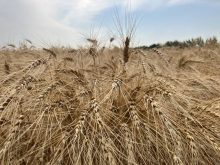Farmers holding wheat stocks have an important decision to make in the next two weeks.
The sign-up deadline for the Canadian Wheat Board’s Series B contract is March 15. It’s the same deadline for the board’s fixed price contract and its basis price contract for the May and July 2012 futures months.
So the question is — do farmers sell their grain into the old crop or new crop market?
“The market is really probably telling you to sell into old crop versus holding it,” said Alberta Agriculture crop market analyst Charlie Pearson.
Read Also

Trump’s tariffs take their toll on U.S. producers
U.S. farmers say Trump’s tariffs have been devastating for growers in that country.
There is little difference between the CWB’s Pool Return Outlook for No. 1, 13.5 percent protein wheat and what grain companies are offering in their new crop contracts. Both work out to about $7 per bushel at port.
Pearson believes wheat prices will not be strong enough next fall to risk carrying over the grain.
The International Grains Council (IGC) has raised its world wheat production estimate for 2011-12 by five million tonnes to a record 695 million tonnes. It also raised its ending stocks to a record 211 million tonnes.
Darren Frank, senior market analyst with FarmLink Marketing Solutions, agreed with Pearson’s assessment.
Spring wheat is now an inverse market where nearby futures are trading higher than the back months.
“That’s always a sell signal,” he said.
His company has been taking out CWB fixed price contracts on low grade wheat.
In its latest PRO commentary, the CWB said abundant production and stocks from the 2011-12 harvest don’t support current futures levels.
However, there is always a chance that wheat prices will rise if growers shy away from the crop in 2012-13.
The IGC forecasts a 1.5 percent increase in global wheat acreage in 2012-13, but production is expected to decline to 680 million tonnes because of dryness in the Ukraine and the United States.
The CWB said the expected drop in next year’s wheat production is overshadowed by the U.S. Department of Agriculture’s expectation for a doubling in U.S. corn ending stocks in 2012-13, driving average corn prices down to $5 per bushel.
Wheat prices tend to follow corn prices.
“Wheat is likely to continue to face some downward pressure in terms of prices,” said Pearson.
That means growers should either sign up for the CWB’s Series B contract, use its fixed price or basis price contracts or forward price their remaining wheat supplies into the new crop year.
“I wouldn’t carry it forward un-priced,” he said.
Growers may find the wheat board’s fixed and basis price contracts preferable to new crop contracts because they provide farmers with a good idea of what they can expect in terms of grade and protein spreads.
“If it was me, the first choice would be to have a hard-core look at fixed price contracts,” said Pearson.
“It eliminates that uncertainty.”
If a farmer decides to go the pooling route, there is a chance the grade and protein spreads in the current PRO will change, but the CWB has already priced 63 percent of the expected 2011-12 crop year deliveries of wheat, so it is unlikely those values will change dramatically.
Some farmers are determined to sell their wheat into the open market once it arrives Aug. 1.
Pearson said that approach is fine, but they should lock in their prices now and they need to keep in mind that they will be left in the dark in terms of grade and protein spreads.
















